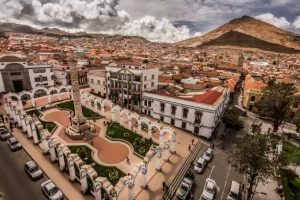Potosí, Bolivia, is a city steeped in history, once one of the wealthiest cities in the world due to its silver mining industry. Perched high in the Andes, this UNESCO World Heritage Site offers a blend of colonial architecture, fascinating history, and cultural experiences.
Essential Information
- Location: Southwestern Bolivia, at the foot of Cerro Rico mountain.
- Altitude: 4,090 meters (13,420 feet) above sea level, making it one of the world’s highest cities.
- Currency: Boliviano (BOB).
- Language: Spanish, with Quechua widely spoken.
- Best Time to Visit: May to October, during the dry season.
Interesting Facts
- Silver Boom: Potosí’s Cerro Rico was the source of vast amounts of silver during the Spanish Empire, contributing to Europe’s wealth.
- Mint of the World: The city was home to the first mint in the Americas, producing coins for Spain.
- Altitude: Its high altitude can cause altitude sickness, so acclimatization is essential.
- UNESCO Status: Potosí is a UNESCO World Heritage Site due to its historic significance and well-preserved colonial architecture.
- Cerro Rico Mines: The mines are still active, with workers extracting minerals under challenging conditions.
How to Get There
By Air
- Closest Airport: Juana Azurduy de Padilla Airport in Sucre, 160 km away. From there, buses and taxis connect to Potosí.
By Bus
- Direct buses operate from major cities like Sucre (3–4 hours), La Paz (10–12 hours), and Uyuni (6 hours).
With Train
- The nearest train station is in Oruro, connecting to Potosí via road.
Best Things to Do
- Cerro Rico Mine Tours: Visit the famous silver mines for a firsthand look at the miners’ lives and work conditions.
- Casa de la Moneda (Mint Museum): Explore the colonial mint and learn about its role in global currency production.
- San Francisco Convent and Museum: Enjoy stunning views of the city from its rooftop.
- Santa Teresa Convent: A fascinating glimpse into the life of cloistered nuns in colonial times.
- Calvario de Potosí: Hike to this viewpoint for panoramic views of the city and Cerro Rico.
- Market Exploration: Wander through local markets for souvenirs, textiles, and traditional Bolivian snacks.
Best Accommodation Options
Luxury
- Hostal Museo Cayara: A restored colonial hacienda with rich history and comfortable amenities.
- Hotel Santa Teresa: Centrally located, combining modern comfort with colonial charm.
Mid-Range
- Hostal Tukos La Casa Real: Known for its warm service and convenient location.
- Hotel Coloso: A modern hotel offering good amenities and a central location.
Budget
- Hostal La Casona: A backpacker-friendly option with clean rooms and a charming courtyard.
- Koala Den: Popular among budget travelers for its friendly atmosphere and helpful staff.
Cultural and Modern Attractions
- Plaza 10 de Noviembre: The city’s central square, surrounded by historic buildings and cafes.
- San Lorenzo Church: Admire its intricate baroque facade and colonial art.
- Laguna de Tarapaya: A natural hot spring located outside the city, perfect for relaxation.
- Colonial Architecture: Walk through the city’s cobbled streets and admire the beautifully preserved colonial buildings.
Dining and Nightlife
Dining
- El Fogón: Famous for its traditional Bolivian cuisine.
- 4060 Restaurante: Offers international dishes and a cozy ambiance.
- Café de la Plata: A charming spot for coffee, pastries, and light meals near Plaza 10 de Noviembre.
Nightlife
- Kultur Café Berlin: A mix of café, bar, and cultural space popular among travelers.
- La Taberna: A laid-back bar offering live music and drinks.
- Pub 4060: Known for its vibrant atmosphere and excellent cocktails.
Day Trips
- Cachi Laguna: A beautiful lake surrounded by serene landscapes, ideal for picnics and photography.
- Pulacayo: Explore this abandoned mining town and its historic remnants.
- Uyuni Salt Flats: A long day trip, but the world’s largest salt flats are worth the journey.
- Tarapaya Hot Springs: Relax in natural thermal pools surrounded by stunning views.
Getting Around
- Walking: The compact city center makes walking the best way to explore most attractions.
- Taxis: Inexpensive and readily available for longer distances or trips outside the city.
- Public Transport: Shared minibuses operate along fixed routes within the city.
Practical Tips
- Acclimatize: Spend a day or two acclimatizing to avoid altitude sickness.
- Warm Clothing: Temperatures can drop significantly, especially at night, so pack layers.
- Local Guides: For mine tours and day trips, hiring a knowledgeable local guide is recommended.
- Safety: While Potosí is generally safe, exercise caution and avoid wandering alone at night.
- Cash: Carry small denominations of bolivianos, as credit cards are not widely accepted.
Conclusion
Potosí is a city of contrasts: its rich history, cultural heritage, and natural beauty make it a must-visit destination in Bolivia. From the historic Casa de la Moneda to the iconic Cerro Rico, every corner of this city tells a story of resilience and grandeur. Whether you’re a history enthusiast or an adventurer, Potosí offers an unforgettable experience.

